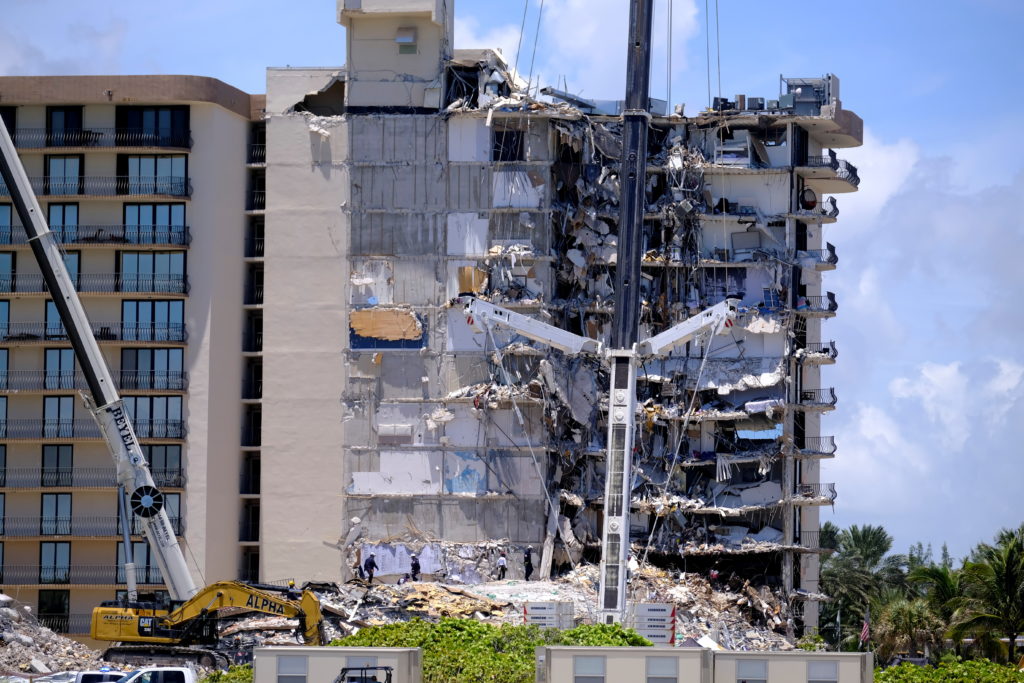It was just after 1:00 a.m. on June 24, 2021, when the calm of a summer night in Surfside, a small beachside town in Miami-Dade County, was abruptly interrupted. A deep, earth-shaking rumble, followed by a dense cloud of dust, rolled through the air. Residents of the Champlain Towers South—a 12-story condominium building—awoke to a nightmarish scene: their home was crumbling beneath them. The tragedy that followed would forever change lives as families scrambled for safety, and cries of fear and confusion echoed in the darkness. The collapse of Champlain Towers South became one of the deadliest structural failures in U.S. history, leaving an entire community in mourning and a nation searching for answers.
The Collapse: A Tragic Event Unfolds
The sudden collapse of Champlain Towers South claimed the lives of 98 people and left many more injured. In an event that lasted less than 12 seconds, over 55 apartments were reduced to rubble, according to the National Institute of Standards and Technology (NIST). This incident became a stark reminder of the hidden vulnerabilities within seemingly stable structures.
The scene was one of devastation: twisted metal, shattered concrete, and belongings strewn across a field of debris. First responders who rushed to the site were met with the overwhelming task of searching for survivors amid a mountain of destruction.
A Building with a Troubled History
Champlain Towers South had stood since 1981, overlooking the serene waters of Surfside. But beneath its façade, the building was no stranger to structural issues. As early as 2018, an engineering report from Morabito Consultants raised alarming concerns about its condition. The report detailed significant structural damage to the pool deck and garage, noting “major structural damage” that required timely and costly repairs.
The Miami Herald later uncovered documents indicating that the condo association had been aware of these findings but faced financial and logistical difficulties in carrying out the necessary work. The delays in addressing these critical structural issues would later be scrutinized as a major factor contributing to the building’s tragic fate.
The Heroic Response: Rescue Efforts Amid Chaos
In the wake of the collapse, rescue teams from across Florida and specialized units from Mexico and Israel arrived to aid local firefighters and emergency responders. The monumental effort involved round-the-clock shifts and cutting-edge technology alongside trained K-9 units. Despite the intensity of the search, the last known survivor was pulled from the wreckage within 15 hours of the collapse.
The operation continued for weeks, shifting from a desperate search for life to the grim task of recovery. Officials confirmed that all victims had been accounted for by the end of July. The final identification of Estelle Hedaya, a vibrant 54-year-old with a love of travel and life, marked the unhappy conclusion to the search and recovery effort.
What Went Wrong? Analyzing the Structural Failures
The collapse of Champlain Towers South was not due to a single point of failure but rather a series of contributing factors. The 2018 report outlined significant cracking and spalling in the concrete, especially in the parking garage and under the pool deck, areas subjected to high levels of saltwater exposure. The oceanfront location, while providing beautiful views, also allowed for saltwater intrusion—a corrosive process that weakened the building’s steel reinforcements over time.
Structural engineer Allyn Kilsheimer, brought in after the disaster to assist with the investigation, commented, “This was a building under significant stress for years before it fell.” As experts pieced together the sequence of failures, it became clear that the aging infrastructure, combined with environmental stressors and insufficient repairs, culminated in the collapse.
Legal and Policy Repercussions
The surfside building collapse tragedy sparked an urgent reevaluation of building safety standards in Florida and across the United States. In response, Florida lawmakers passed legislation in May 2022 requiring that condominium buildings taller than three stories undergo structural inspections every 30 or 20 years for those within three miles of the coastline. This new law aims to catch structural wear and tear signs early, preventing future calamities.
The financial and legal repercussions were significant as well. In June 2022, the survivors and victims’ families reached a settlement totaling over $1 billion, providing some measure of closure and financial relief to those who suffered unfathomable losses.
The Human Toll: Faces of the Fallen
Behind the numbers were individuals whose lives were cut short in an instant. The Champlain Towers South community comprised retirees enjoying their golden years, young professionals, families with small children, and vacationers. Among them was Estelle Hedaya, who symbolized the long and arduous recovery process. Her friends described her as someone full of joy and energy, always the life of the party. Each victim had a unique story, and in the wake of the collapse, these stories emerged to remind the world of the human cost of such tragedies.
Lessons Learned and Moving Forward
The collapse of Champlain Towers South has left an indelible mark on Surfside and beyond. It serves as a cautionary tale that underscores the importance of proactive maintenance, transparent communication, and adherence to safety regulations. Buildings in coastal areas are particularly vulnerable, and the Surfside disaster has led to calls for stricter building codes and more frequent inspections to catch potential structural weaknesses before they turn catastrophic.
Experts believe this tragedy, as devastating as it was, can be a turning point in building safety practices. Municipalities are now rethinking how they assess structural integrity and manage older buildings, ensuring that future residents won’t suffer the same fate.
Conclusion: Remembering and Learning
The Champlain Towers South collapse is a sad reminder of the lives lost and the communities shattered by inadequate oversight and deferred maintenance. As Surfside continues to rebuild, the legacy of those who perished becomes a driving force for change, highlighting the need for diligence, transparency, and care in how buildings are maintained and inspected.
That night in June 2021 was a tragedy that must not be repeated. The lessons learned from this catastrophe will serve as a guide for safer infrastructure and better protection for those who call these places home. May the memory of the 98 lives lost compel us all to prioritize human safety over complacency and inaction.






